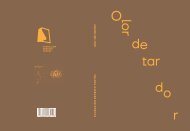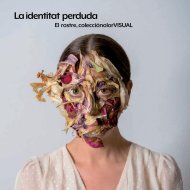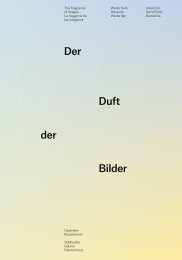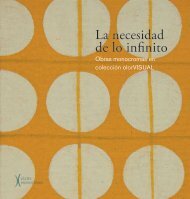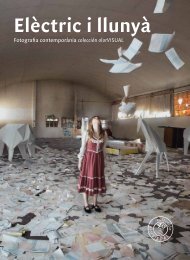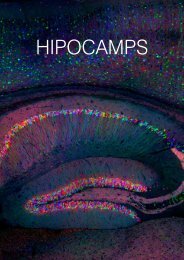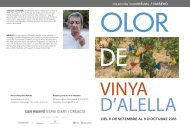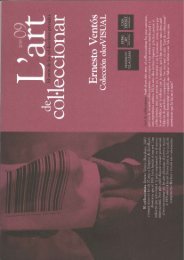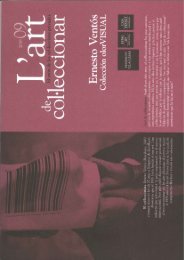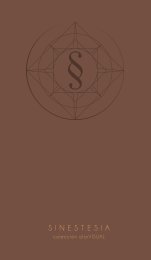You also want an ePaper? Increase the reach of your titles
YUMPU automatically turns print PDFs into web optimized ePapers that Google loves.
lnitiation and apprenticeship in the world<br />
ot smells<br />
Ernesto Ventós Omedes<br />
I was born into a family which has for<br />
generations, as a tradition passed on<br />
from father to son, been a part of the<br />
world of fragrances and perfumes. I grew<br />
up in a house in the Sants-Les Corts<br />
neighbourhood amidst drums of essential<br />
oils that tilled the air with the seent ot<br />
lavender, mint and orange, the last two<br />
being my tavourites as demonstrated<br />
later by my greedy liking for sweets.<br />
Summers in the country at my<br />
maternal grandmother's house were an<br />
important part of my early olfactory<br />
experiences: the smell ot the damp earth<br />
mixed with the aroma of the eucalyptus<br />
trees after the rain; the fragrance of<br />
herbal infusions; the pungent whiff of<br />
naphthalene that became conspicuous for<br />
just a few days a year when the season<br />
changed; the sweet honeyed perfume of<br />
pipe tobacco; and even the unpleasant<br />
smell ot the cellar with its mixed odour ot<br />
damp newspaper, wood and oid clothes.<br />
All this plus the reek of manure and its<br />
special ability to make any other smell<br />
stronger. These without doubt are my first<br />
encounters with smells despite the fact<br />
that my true apprenticeship began when I<br />
started working alongside my father in<br />
the house in Sants and progressed<br />
particularly during the three years that I<br />
spent in Switzerland and France as<br />
assistant to the great master Arturo Jordi.<br />
This was how I became familiar with<br />
the various essences and their characteristics,<br />
while at the same time training<br />
the memory of my nose. Detailed study of<br />
all the various components was essential<br />
to be able to learn gradually how to create<br />
formulae and how to apply them to the<br />
various products. lt was an intense<br />
apprenticeship or initiation, that was<br />
moulded and perfected by the daily<br />
experience of the slow, considered process<br />
vital to the birth of a new perfume. lt is a<br />
task that requires a lot of time, a creation<br />
that must be approached without haste as<br />
you need to be aware that when you want<br />
to give material shape to a new idea,<br />
drawing up the formula will take many<br />
months of work and that despite the all<br />
the dedication and effort you put into it,<br />
the life of the perfume may be relatively<br />
short. Throughout the course of an entire<br />
year, I maybe make up some ten or twenty<br />
formulae, of which it is very likely that<br />
only one or two are perhaps of interest,<br />
while the rest, if they are not marketed,<br />
lose their value very quickly.<br />
To create a perfume, you need to spend<br />
tim e experimenting and researching, in the<br />
same way that you also need to<br />
experiment and conduct research over a<br />
long period to create a work of art. But<br />
unlike a work of art, the perfume designer<br />
works largely to commission, offering his<br />
or her services to a client who determines<br />
the basic characteristics of the fragrance<br />
required depending on the market it is<br />
aimed at and, above all, after research into<br />
the people who are to buy it, their tastes,<br />
their social origin, cultural level and even<br />
into fashions and climate. Right from the<br />
start, a perfume has avalue as a consumer<br />
product.<br />
In this respect, once launched onto the<br />
market, perfume adapts to the characteristics<br />
of the consumer in such a way<br />
that normally the perfume chosen by<br />
each person reflects his or her character,<br />
lifestyle, preferences and personality.<br />
Hence, a perfume reveals a lot about us.<br />
There is no doubt that there are perfumes<br />
that are serious, classic, modern, liberal,<br />
extravagant - a whole host for every taste<br />
so that everyone eventually feels singled<br />
out and identified according to their<br />
individual nature.<br />
lt should also be pointed out that<br />
mixing perfume with one's own skin seent<br />
alters the smell ot the essences and<br />
balsams that make it up, which is why it is<br />
said that a perfume undergoes slight<br />
changes when worn, personalising each<br />
fragrance.<br />
Another issue which I feel it is necessary<br />
to mentien here relates to changes in social<br />
stereotypes. Recently, we have seen how<br />
harsh essences, such as cedar and common<br />
flowers, which are popular in colognes for<br />
men, are now also being used by women.<br />
This clearty reveals that now that men and<br />
women are growing closer, so are their<br />
fragrances, and also demonstrates that the<br />
age-old barriers regarding seent are<br />
increasingly breaking down.<br />
The initiative behind the collection<br />
The idea ot starting up a collection<br />
based on a visual work created using sense<br />
of smell perceptions arose in 1978 as a<br />
result of an exhibition entitled 0/fadory<br />
Suggestions involving a number of<br />
perfumers that was held at the Joan M iró<br />
Foundation in Barcelona. The topic was<br />
very broad and the show tried to cover the<br />
wide spectrum of the world of smell: the<br />
fragrances of the body, the smells of<br />
colours, the odours of animals, the raw<br />
materials that give off seents (plants), the<br />
physiology of the sense of smell, smell and<br />
popular culture, fashion in smells and the<br />
literature of smells.<br />
When I noticed that there was nothing<br />
exhibited on the walls in the exhibition, I<br />
felt the need to get in touch with painters<br />
and sculptors to make them part of my<br />
initiative, which had to mature over time.<br />
First, I tried writing to artists and gallery<br />
owners, but the response was poor. I<br />
myself had to contact each of the artists to<br />
present my proposa! and to try to<br />
encourage them to share in the shaping,<br />
representation or reflectien of olfactory<br />
sensations and to inspire them into being<br />
capable of visually communicating these<br />
immaterial essences to the onlooker.<br />
lt is quite clear that the suggestion was<br />
an enriching challenge for all the artists,<br />
offering them a way of linking up to a<br />
different level of communication with a<br />
language that is very imaginative in its<br />
development while at the same time being<br />
intellectual; a language that is a very<br />
aware plastic interpretation of inhaling the<br />
externa! world.<br />
I am now pleased to be able to present<br />
a selection of my collection, which has<br />
been shaped by the close dialogue<br />
between the suggestive evocative worlds<br />
of the visu al and the olfactory so that the<br />
public can share it with us and can draw<br />
from it their own conclusions.<br />
Learning to use our sense ot smell in<br />
order to understand understanding in<br />
order to use our sense ot smell<br />
Notes on the lecture entitled The Sme/I<br />
of Art given by Ernesto Ventós Omedes in<br />
Lucta (Montornès del Vallès) in 1994.<br />
In his latest work, Seeing and<br />
Understanding Painting, Bernard Rancillac<br />
takes his experience as a painter and<br />
provides us with the keys to the doors of<br />
the realm of painting, analysing the<br />
various levels that link the onlooker with<br />
the coded language of art.<br />
Smelling and Understanding Painting<br />
is my personal adaptation of t he title and<br />
of some of the passages in Rancíllac's<br />
work -which I will go on to detail at<br />
certain points- to demonstrate based on<br />
my own experience that there is another<br />
sense, the sense of smell, that can also aid<br />
our understanding of the language of art.<br />
Art is a coded language, so it is essential<br />
that we acquire a specialist view of it in<br />
order to be able to understand it. Similarly,<br />
it is not sufficient simply to breathe in<br />
through the nose - to smell, inhale or sniff<br />
- in order to reveal the codes that are<br />
particular to perfume. Thus, the way we<br />
look at the outside world is not the same<br />
as the way we look at a work of art, which<br />
requires a degree of education. Visual<br />
perception, just like the sense of smell,<br />
adapts itself to the nature of the objects<br />
we perceive.<br />
When we are born, all our physical<br />
senses start to work, though poorly at first<br />
due to our lack of knowledge of the<br />
various stimuli that affect them. This being<br />
the case, however, it is highly probable<br />
that the first things we learn to distinguish<br />
in life are the smell of our mother, food,<br />
home - the things that are closest to us<br />
and which are most familiar to us. Even<br />
though we cannot yet appreciate it at this<br />
stage, it is very likely t hat we are guided<br />
by our sense ot smell as we discover the<br />
world around us. Our sense of smell is<br />
therefore one of the most important basic<br />
tools we have for our own development<br />
and understanding of our surroundings.<br />
We should bear in mind that our sense<br />
of smell is the only on e that we cannot cut<br />
off by force of w ill, unlike our other senses<br />
which we can neutralise by closing our<br />
eyes, shutting our mouth, blocking our<br />
ears or simply by avoiding touching things.<br />
lt is impossible for us to close ourselves off<br />
from externa! emanations and smells<br />
because it is obvious that we cannot live<br />
without breathing.<br />
For this reason, it is easier when we are<br />
children for us to describe what we<br />
perceive through our sense of sight,<br />
hearing, taste or touch because we are<br />
able to exercise control over it. But this is<br />
not the case with our sense of smell; this<br />
source of perception is completely<br />
unavoidable and abstract.<br />
From the time we are bom, we all carry<br />
around with us experiences we have been<br />
through or felt that are stored away in our<br />
memory until it builds up into a considerable<br />
repository, with all the cultural connotations<br />
that society inculcates into us. We become<br />
able to perceive the wortd al most effortlessly<br />
thanks to it despite the fact that an entire<br />
accumulation of experience is insufficient to<br />
be able to acquire a special sense of sight<br />
and that what we really need is a certain<br />
apprenticeship that will crystallise during our<br />
daily work.<br />
As Rancíllac says, "no-one has become<br />
a painter simply by looking at nature, a<br />
pretty tree or a ~eautiful woman".<br />
Likewise, no-one can become a creator of<br />
perfumes solely by smelling a magnificent<br />
fragrance. Much has been written about<br />
making perfumes and there is still a lot<br />
being published on the world ot aromas<br />
and fragrances, but unfortunately it is<br />
always in an anodyne and incomplete<br />
fashion. The book that analyses the world<br />
of perfume to the full has not yet been<br />
written.<br />
Learning about smell is essential in order<br />
to break the code of perfume, but it is the<br />
condensation of over 40 years of<br />
experience that assures me that it is not<br />
only necessary to study the mechanics and<br />
techniques and to àpply them to good<br />
working methodology, but that a great love<br />
of the art and craft is also an essential<br />
element enabling us to breathe life into our<br />
creations. A perfume or aroma without a<br />
soul can never be a fully achieved work. For<br />
every creator, therefore, emotion is not the<br />
be all and end all - he or she needs to know<br />
the job, which must be formed and shaped<br />
day by day, and to find pleasure in what he<br />
or she does.<br />
The perfumer, just like the artist, has a<br />
wide range of elements to combine in his<br />
or her creations. The painter, for example,<br />
knows that pictorial languages are<br />
developed based on scientific and artístic<br />
experimentation on the visual qualities of<br />
colour. Colour - like any other concept - is<br />
an important element of expression and its<br />
power and symbolism are well known to<br />
all experts who recognise its close<br />
relationship with the other senses.<br />
The colour red, for example, swiftly<br />
suggests passion, love and even the<br />
violence of blood, which is why it is used<br />
in perfume making to characterise serious<br />
colognes and sophisticated perfumes. Blue<br />
is unquestionably a relaxing colour<br />
denoting gentleness. freshness, joy and<br />
nobility, and is the typical colour ot marí ne<br />
fragrances. Green is associated with young<br />
plants and is a colour common to<br />
shampoos and cleaning products; because<br />
it symbolises nature, life and growth it is<br />
used in youthful colognes made using<br />
natural ingredients. Romance, wisdom,<br />
purity and cleanliness are concepts that<br />
are always allied to the colour white,<br />
w hich is normally used in beauty and<br />
hygiene products. Black is loaded with<br />
symbolism and is related to heady,<br />
alcoholic perfumes. Yellow exemplifies the<br />
sun, light and youth, and is a normal<br />
colour for colognes for all the family. Gold<br />
symbolises power and luxury.<br />
We can clearly see that the abundant<br />
and unrestrained connotations of colour<br />
corne immediately to mind and that they<br />
have a psychological effect. Obviously,<br />
however, there are unavoidable límits to<br />
some extent to their use. Bringing together<br />
form and colou r and their particular<br />
dynamics creates an inexhaustible reserve<br />
of plastic combinations which are not<br />
necessarily appealing or pleasant but which<br />
should instead express certain subjective<br />
stances.<br />
We need to be very clear that the<br />
purpose of visual art is not to please but to<br />
move, for, as Schumann said, "the artist's<br />
mission is to send light into the depths of<br />
the human heart". The artist's duty<br />
therefore consists not merely of mastering<br />
torm in a pure exercise on shape, but of<br />
adapting it to the contents that are to<br />
move the onlooker and to force him or her<br />
to re-experience certain sensations. The<br />
artist, according to Kandinsky, must<br />
educate him or herself and look into his or<br />
her own soul, taking care of it and<br />
developing it so that his or her externa!<br />
talent has robes to put on and is not<br />
simply like a lost glove from an unknown<br />
hand, a simulacrum of a hand, empty and<br />
without meaning.<br />
In this way, as Rancillac suggests, if you<br />
want to go deeper into the language of<br />
the plastic arts and grasp its specific<br />
connotations, it is essential to learn how to<br />
appreciate it. We need to learn that the<br />
artístic experience will bring us no pleasure<br />
or joy until we can assimilate it perfectly.<br />
This means that the satisfaction that<br />
makes up this experience, our drawing<br />
close to a work of art, is not an easy task,<br />
but instead becomes a rigorous intellectual<br />
and moral way forward. Thus, artístic<br />
creation is not a ripe fruit ready for eating.<br />
In order to enjoy it, we must follow a<br />
process that the artist him or herself has<br />
left unfinished.<br />
A major element in many plastic works of<br />
art is drawing. Through the line or the<br />
150<br />
151




